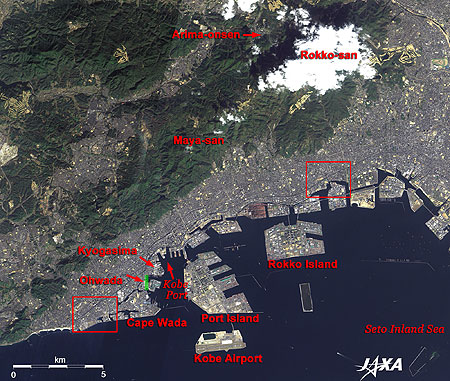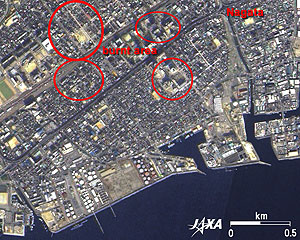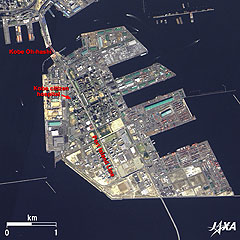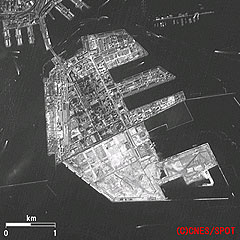Seen from Space 2007
Port City KOBE "Revival from Earthquake Disaster"
The Arima Onsen (Spring) at the foot of Mt. Rokko is very famous as one of the three oldest hot springs in Japan. Japanese warrior General Toyotomi Hideyosi (1536/37-1598), who unified Japan in that era, was very fond of Arima Onsen and visited there many times. There are many piers and much reclaimed land along the coast; Port Island and Rokko Island are the most conspicuous. Port Island, an artificial island completed under the first construction plan in 1981, is home to the Kobe Citizen Hospital, which serves citizens in the area, and supports general city functions. Port pier '81 Exhibition was held here in 1981. Port Island connects with central Kobe via the Kobe Great Bridge and the Tsusima tunnel, as well as the Sin Kotsu Port Island Line, which opened in 2006. Rokko Island is also an artificial island and hosts a town called Kouyou. The reclamation project was finally completed in 1993, and the first residential area was developed in March 1988; since then, many people have moved into the area. Facilities for city functions are still being developed. A reclamation project has been underway to the south off Rokko Island since 1998 in order to provide a waste disposal area. Oowada no Tomari had served as a natural port of Kobe since ancient times. People of that era traded with merchants on the Chinese continent and the Korean peninsula through this port. At the height of the "Heisi prosperity," Tairano Kiyomori (1118-1181) constructed the foundation of the present international port and city. The port "Owada no Tomari," which was restored by Kiyomori (Tairano Kiyomori), is now being reclaimed and is estimated to be located in the area marked by the green line in Fig. 1. It was such a good port that ships sailing around Wada Promontory and entering the inlet are protected from the strong west wind by the promontory jutting out into the sea. The embankments on the northeast side were frequently destroyed by the flooding of old Minato River, strong winds, and waves. Kiyomori constructed a strong artificial island called "Kyougasima" on the northeast side. Kyougasima is estimated to be located in the area indicated by the arrow in Fig. 1. After Owada no Tomari was restored, it began to serve as an international port trading with So (a dynasty on the Chinese mainland) in the Heiann era (794-1192) and with Min (another dynasty on the Chinese mainland) in the Muromachi era (1336-1573). After the battle of Genpei (about 1185) Kobe City was devastated by continuous war. Its role as the center of sea trade was transferred to Sakai City in Osaka. Owada no Tomari was renamed "Hyougo no Tsu" in the Edo era (1603-1868), and foreign trade ended due to Japan's closed-door policy. Kobe City, however, built up its position as the kitchen for the Japanese nation and the main port for Osaka and gained importance in marine transportation as the primary port connecting Osaka and Edo (present day Tokyo) once the western route (the Japan Sea coasts - the Kanmon Straits - Osaka - Kii Peninsula - Edo) was established. The port of Kobe was reopened in 1886 after the arrival of Perry's fleet (8 July 1853). Following that, Kobe overcame numerous hardships such as the Hansin Flood and the Pacific War and developed into a large city with a population of 1 million.
Figure 4 compares images of the vicinity of Port Island acquired at the beginning of this year (2007; left) and just after the earthquake (right) . It is estimated that liquefaction occurred in the white parts of the image just after the earthquake. It took around three years to restore all railways and roads and two years to restore the main port facilities. The Kobe airport (Marin Air) opened in 2006 and an integrated sea, land and air transportation system was established. Kobe City, which inherited the enterprising spirit from Tairano Kiyomori, overcame most of the great damage inflicted by the Hansin Awaji Earthquake itself and is now developing as one of Japan's most attractive cities.
|
|||||||||||||||||||||||||||||||||||||||||||









